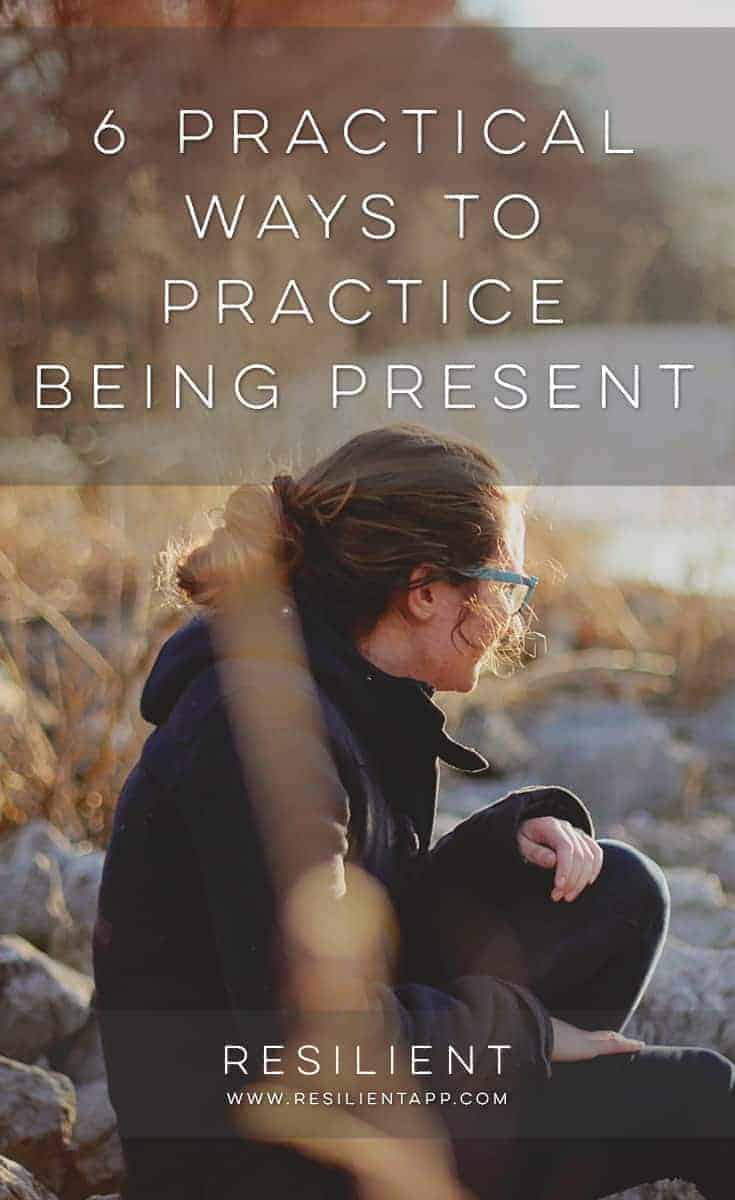6 Practical Ways to Practice Being Present
This post was written by Leo Babauta, originally for Zen Habits. Republished here with permission.
There are a lot of amazing benefits to being more present and mindful, but one of my favorites is this: you’re not missing the beauty and joy of the present moment. Here are 6 practical ways to practice being present.

6 Practical Ways to Practice Being Present | How to Be Present in Life
Being present also helps you to see when you are feeling fear or resistance, uncertainty or the urge to procrastinate, anger or resentment … and then to work with those difficulties mindfully.
That’s all great, but how do you remember to practice being present? It’s so easy to get caught up in our thoughts and distractions, and forget to practice.
The honest truth is that no one is perfect at this. Me least of all. It’s a continual learning process, not something you figure out and then you’re good. It’s messy and beautiful.
So with that in mind, here are some practical ways to practice:
1. A Small Regular Practice. Form the simple habit of meditating for just two minutes a day (to start with). After you wake up, simply sit comfortably and try to focus on your breath for two minutes. When (not if) your mind wanders, just notice it and label it “thinking.” And gently return to the breath, without harshness.
Set a timer, and when the timer goes off, you’re done! If you feel like expanding it by a minute every week or so, feel free to do so, but you don’t have to expand. The benefit of this regular practice is that you learn skills you can take and practice in other parts of your day.
2. Work with Others. Having a regular group or partner to meditate with is helpful. You support each other continuing to practice, and can talk about struggles and things you’re learning. If you don’t have a practice group in your area, you could find people online to talk to regularly about practicing.
Products We Recommend:
3. Have Mindfulness Bells. You could have a chime regularly sound off on your phone or computer (numerous apps do this) to remind you to pause and be mindful of what’s going on right now. I’ve also found it useful to see other things as mindfulness bells: seeing my child’s face, a traffic light, hearing an alert from an appliance or the computer. Each of these can be a reminder to be present when I notice them.
4. Set an Intention Before an Activity. If you’re about to do a work task, process email, read a book, cook dinner … you can pause just before starting, and think for a second about what your intention for that activity might be. What are you hoping to do with this activity?
For me, I might cook dinner out of love for my family or myself. I might write a blog post (like this one) out of love for my readers. I might do a workout out of love for myself (and to set a good example for my kids). I process email out of responsibility and consideration for those trying to communicate with me.
By setting an intention, it reminds you to be mindful of that intention as you do any activity.
More Posts You Might Like:
- The 3 Day Rule That Can Change Your Life
- 25+ Self Improvement Tips
- 30+ Journaling Prompts
- How to Improve Your Life Overnight
- 10+ Personal Growth Books
5. Reflect Daily. At the end of each day, or at the beginning, take a minute to journal or just reflect on how your day has gone. How have you done with practicing being present? What have you struggled with? Have you been using your mindfulness bells and setting intentions?
What resistance has come up for you, what stories are you telling yourself about all of this? Daily reflection is one of the most useful habits for continuing to practice and getting better at practicing.
6. See Everything as a Teacher. This method admittedly sounds a bit corny, but it’s actually amazing. When you’re feeling frustrated with someone, feeling stressed out by work, feeling upset or grieving about the health of a loved one, feeling anxious about a national election … pause and see this person or situation as a teacher.
What can you learn from them about being present? What attachments can you see in yourself that are causing this difficulty? What stories are you forming that are causing you to feel this way? What can you practice letting go of? What can you appreciate about this moment that you are taking for granted?
In this way, every difficulty, every person, everything that arises in the present moment can be a loving teacher that is helping us along the path to being present.

The Amazing Power of Being Present
How can you bring calm and peace to the middle of a stressful, chaotic day? The answer is simple, though not always so easy to put into practice: learn to be present. Here is the amazing power of being present.
No matter how out-of-control your day is, no matter how stressful your job or life becomes, the act of being present can become an oasis. It can change your life, and it’s incredibly simple.
When I asked people what things prevent them from having a peaceful day, some of the responses:
- Work, the internet, my own lizard brain.
- Social media and other digital distractions.
- For me it’s too many things coming at me all at once. Whether it’s news, or decisions, or work to be done.
- Needless interruptions.
- My own monkey mind.
The amazing thing: all of these problems can be solved by one technique. Being present.
How Being Present Solves Problems
When you look at all of the problems above, you can see if you look closely that the problems are entirely in the mind. Sure, there are external forces at work: an uncontrollable job, the stress of chores and interruptions and digital distractions. But it’s how our mind handles those external forces that is the problem.
If you are completely present, the external forces are no longer a problem, because there is only you and that external force, in this moment, and not a million other things you need to worry about.
If your job demands that you focus on an urgent task, you can stress out because you have a million other things to do and not enough time to do them.
Or you can be present, and focus completely on that task, and now there is only that one task and you. When you’re done, you can move on to the next task.
Social media and other digital distractions don’t interrupt us if we close them and learn to pour ourselves completely into the present task. And if we need to do email, Twitter, or read blogs, we can set aside everything else and just be present with that one digital task.
Being present becomes, then, a way to handle any problem, any distraction, any stressor. It allows everything else to fade away, leaving only you and whatever you’re dealing with right now.
How to Practice Being Present
The method for being present is fairly simple, but it’s the practice that matters most.
Most people don’t learn to be present because they don’t practice, not because it’s so hard to do.
When you practice something regularly, you become good at it. It becomes more a mode of being rather than a task on your to-do or someday list.
Practice, practice, and being present will become natural.
Here’s how to do it: whatever you’re doing, right now, learn to focus completely on doing that one thing. Pay attention: to every aspect of what you’re doing, to your body, to the sensations, to your thoughts.
You will notice your thoughts, if you’re paying attention, jump to other things. That’s OK — you are not trying to force all other thoughts from your mind.
But by becoming aware of that jumping around in your thoughts, you have found the tool for gently bringing yourself back to your present task. Just notice the jumping thoughts, and lovingly come back.
Do this once, then do it again. Don’t worry about how many times you must do it. Just do it now.
It can become tiring at first, if you’re not used to it. Don’t worry about that. Let yourself rest if you grow tired. Come back and practice again in a little while. It’s not meant to be exhausting — instead you should notice how your worries melt away and you enjoy your present task much more.
Be joyful in whatever you’re doing, grateful that you’re able to do that task, and fully appreciate every little movement and tactile sensation of the task. You’ll learn that anything can be an amazing experience, anything can be a miracle.
Practice throughout your day, every day. Little “mindfulness bells” are useful to remind you to come back to the present. Thich Nhat Hanh once recommended that stoplights be your mindfulness bell as you drive.
You can find mindfulness bells everywhere: a loved one’s voice, your co-workers appearing before you, a regular event on your computer, the noise of traffic.
Meditation is a fantastic way to practice, only because it removes much of the complexity of the world and allows you to just learn to be aware of your mind, and to bring yourself back to the present moment. It’s not complicated: meditation can be done anywhere, anytime.
Practice, repeatedly, in small easy beautiful steps. Each step is a wonder in itself, and each practice helps you to find that calm in the middle of the traffic of your life.
‘Drink your tea slowly and reverently, as if it is the axis
on which the world earth revolves – slowly, evenly, without
rushing toward the future. Live the actual moment.
Only this moment is life.’ ~ Thich Nhat Hanh
